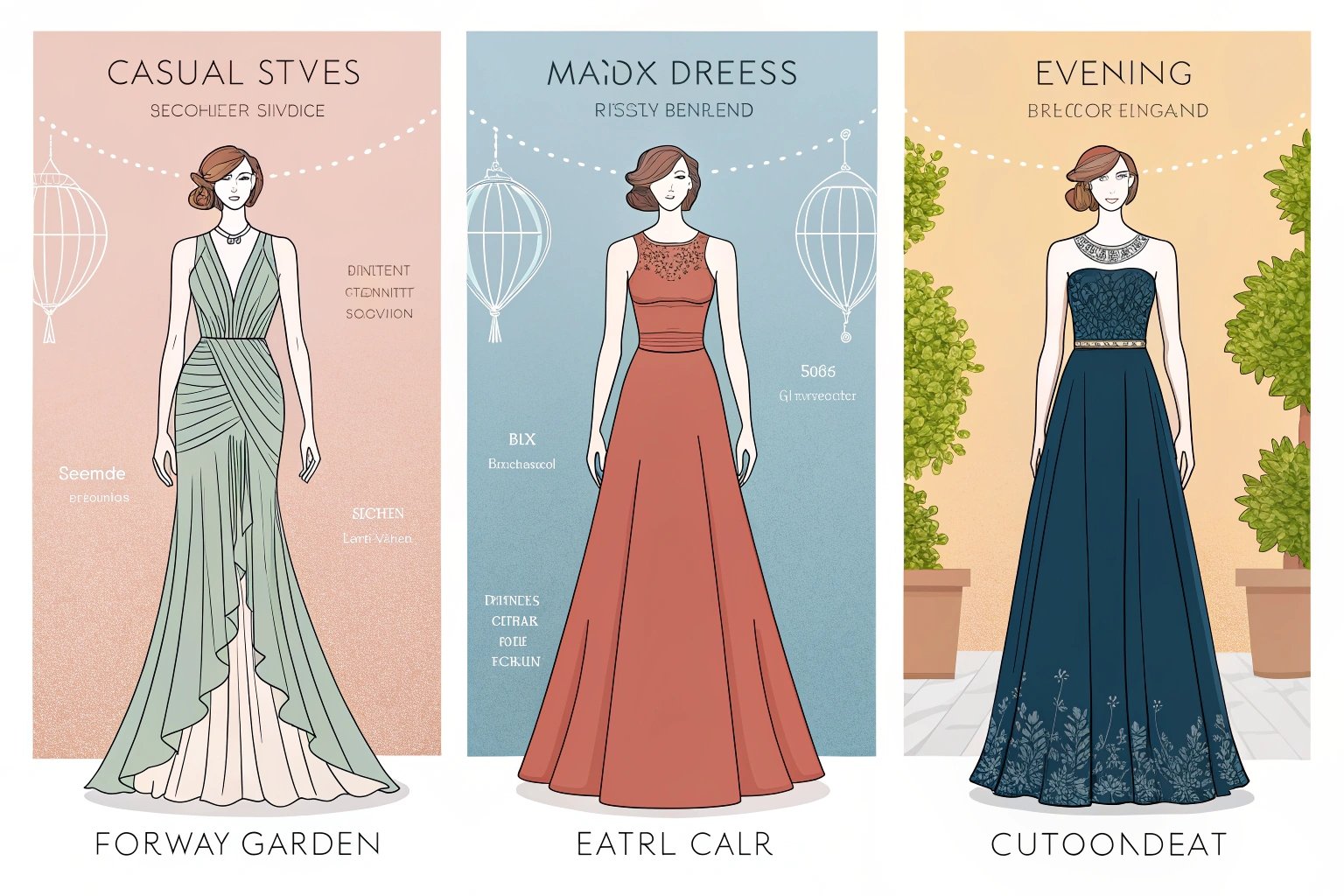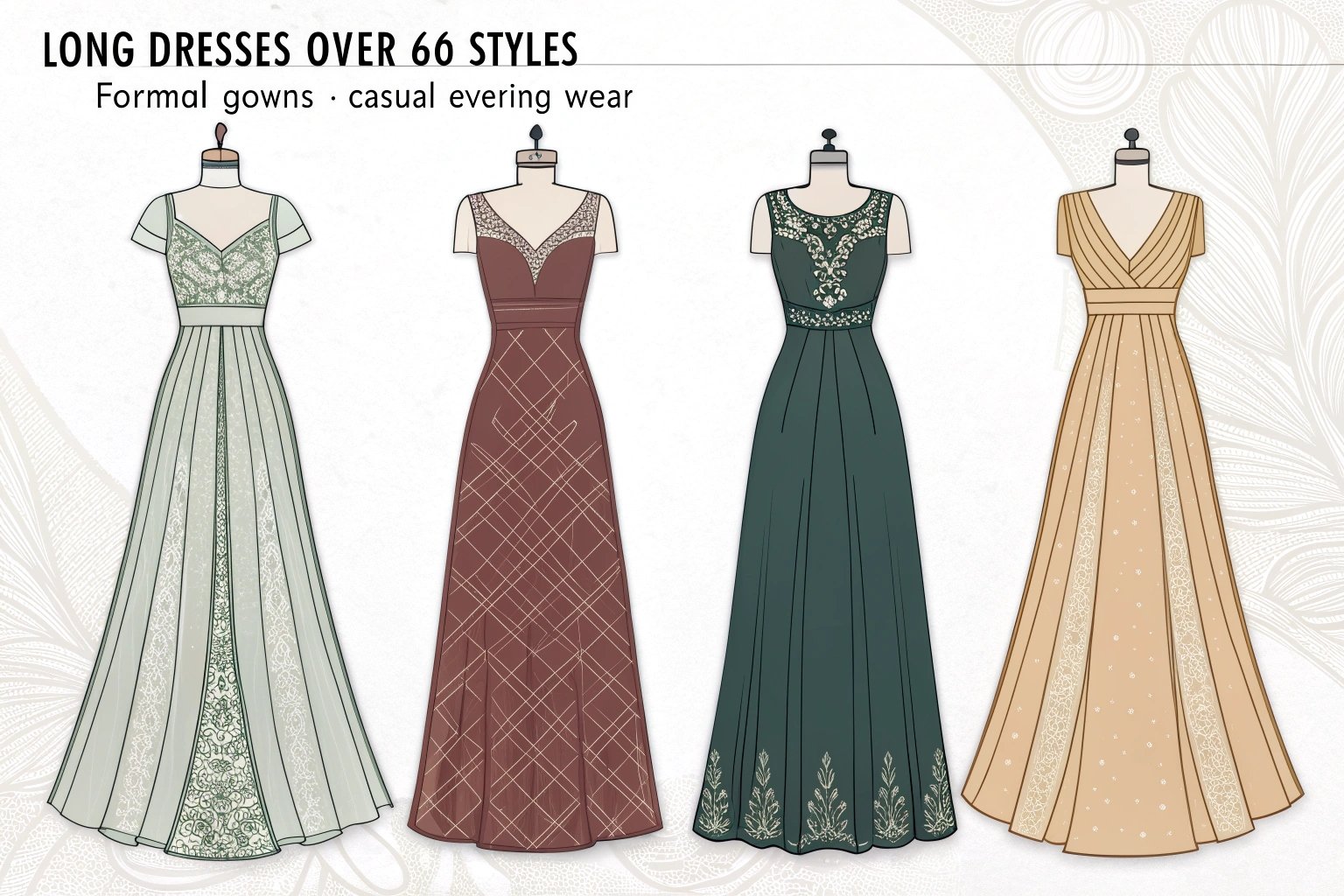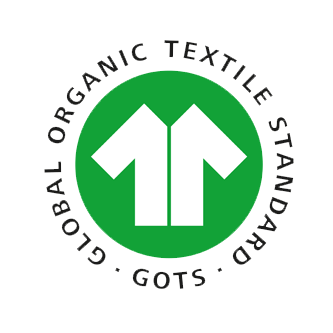In the first three parts of our Sleeve Design Series, we’ve built a detailed roadmap for understanding sleeve construction, function, and trend alignment. Part 1 focused on the foundational structures—like set-in, raglan, kimono, and drop shoulder—explaining how each affects garment silhouette and comfort. Part 2 expanded into over 70 sleeve types, showing how style, volume, and cut influence both brand identity and market response. Part 3 applied this knowledge across key product categories, analyzing how sleeves adapt to dresses, outerwear, tops, and seasonal demands.
Now, in Part 4, we turn our attention to production logic—how sleeve design impacts manufacturing, pricing, scalability, and communication with suppliers. From sampling complexity to MOQ restrictions and lead time risks, this chapter is built for fashion professionals who want to create sleeves that work as beautifully in the factory as they do in the design room. This final part bridges creativity and execution—helping you make informed decisions across the full product lifecycle.
Laced Sleeve

What makes laced sleeves a distinctive element in women’s fashion design?
Laced sleeves are visually striking and emotionally evocative—often used to create softness or sensuality.
Laced sleeves use lace fabric or lace trim to add texture, transparency, and detail to the sleeve design. They’re popular in eveningwear, bridal, romantic fashion, and modern edgy styles, adding visual complexity and a sense of femininity.
What are the common styles of laced sleeves in modern fashion?
There’s no single rule for how lace is used on sleeves—designers get creative.
Laced sleeves come in full-lace styles, part-lace panels, or sleeves with lace inserts, trims, or appliqué. Some are entirely transparent, while others combine lace with solid fabrics for contrast.
You’ll find laced sleeves in multiple silhouettes—from long bishop and bell sleeves to fitted cap sleeves or puff sleeves with lace insets.
Common laced sleeve applications:
- Full lace sleeves – fully sheer, often unlined
- Lace panel sleeves – lace inserted into solid fabric
- Lace-trimmed sleeves – lace edge details
- Lace-appliqué sleeves – solid base with lace patterns applied
How do laced sleeves affect garment design and perception?
Lace changes not just the look—but the mood—of a design.
Laced sleeves often add elegance, delicacy, or sensuality to a piece. Whether used for bridal gowns or edgy fashion tops, they balance exposure and coverage in a strategic way.
When I design with lace, I always consider whether it supports or overpowers the silhouette. Sometimes it’s better as a highlight, not the main act.
Exploring the technical and design roles of laced sleeves
1. Material Compatibility
Lace is not one fabric—there are many types:
| Lace Type | Visual Effect | Best Used In |
|---|---|---|
| Chantilly Lace | Fine, floral, sheer | Bridal, eveningwear, sheer sleeves |
| Guipure Lace | Heavier, no net base | Modern jackets, contrast inserts |
| Stretch Lace | Soft, body-hugging | Casual or fitted designs |
| Embroidered Lace | Rich, textured patterns | Couture, statement pieces |
When combining lace with other fabrics, weight and stretch compatibility are critical. Light silks, crepes, or mesh often pair well. Avoid thick or stiff textiles that disrupt the lace’s flow.
2. Sleeve Structure and Support
Laced sleeves can be fragile and may require structural reinforcement:
- Use of lining or nude mesh underneath to retain sleeve shape
- Edge reinforcement using piping or binding to prevent tearing
- Strategic seam placement to maintain drape and avoid lace distortion
Designers must also consider movement—lace sleeves that are too tight can restrict the arm or tear easily.
3. Aesthetic Styling Potential
Laced sleeves play different roles depending on the style direction:
- Romantic & feminine: Full lace bishop sleeves with soft gathers
- Vintage-inspired: Cap sleeves or short puff sleeves with delicate lace trims
- Modern & edgy: Black lace sleeves paired with structured bodycon silhouettes
- Bohemian: Wide bell sleeves with floral lace patterns
Laced sleeves can also be styled to bridge casual and formal wear depending on how much skin is exposed and how heavy the lace is.
Detachable Sleeve
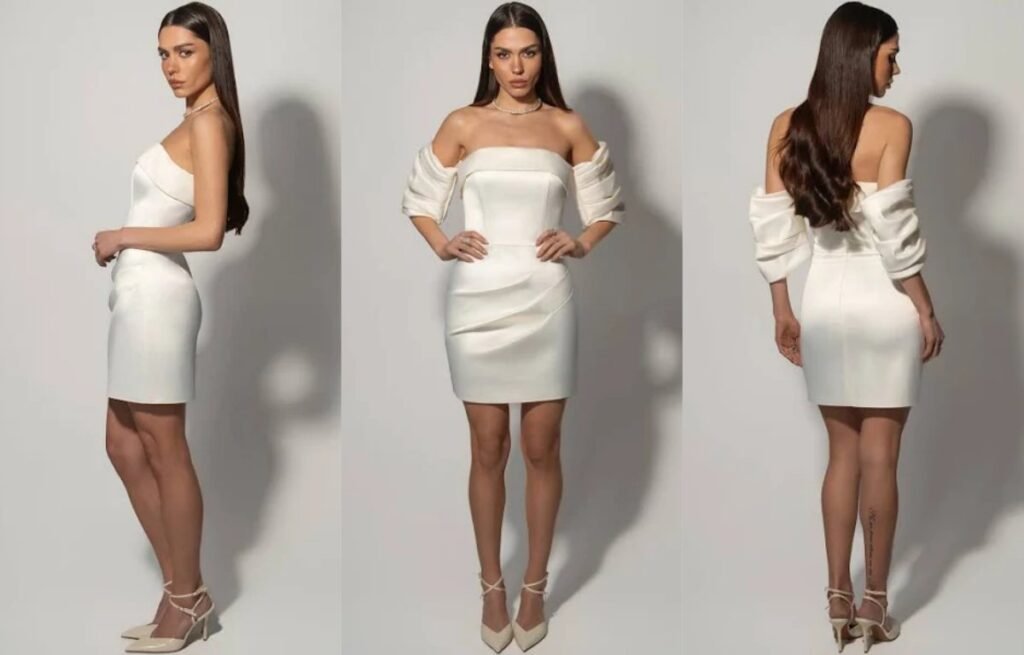
Why are detachable sleeves gaining popularity in women’s fashion design?
Detachable sleeves aren’t just trendy—they’re redefining multi-functional design.
Detachable sleeves allow one garment to transform into multiple styles, offering both fashion flexibility and functional adaptability. This trend reflects the growing demand for modular and sustainable design.
I once helped a client design a dress with zip-off puff sleeves. It instantly became two looks in one—and her customers loved the versatility.
How do detachable sleeves work and what makes them functional?
It’s more than just taking a sleeve off—it’s about how it’s engineered.
Detachable sleeves are usually connected using zippers, buttons, snaps, or hidden hooks. They’re designed to be secure, easy to remove, and integrated into the garment without disrupting its silhouette or stability.
You’ll find them in streetwear, outerwear, formal dresses, and even activewear—each with its own fastening technique and design logic.
Common types of sleeve attachments:
| Attachment Type | Features | Best Used For |
|---|---|---|
| Zipper | Secure, modern look, visible or hidden | Outerwear, streetwear |
| Snap Buttons | Easy to attach/detach, minimal visibility | Blouses, lightweight jackets |
| Fabric Loops | More decorative, less structural | Eveningwear, dresses |
| Hidden Hooks | Seamless integration | Couture, tailored pieces |
What are the pros and cons of using detachable sleeves?
Modularity comes with both creative freedom and design challenges.
Pros include versatility, seasonless functionality, and travel-friendly appeal. But drawbacks include added construction complexity, durability concerns, and the risk of compromising garment structure if poorly executed.
For some styles, especially tailored garments, maintaining fit and shape with removable parts can be tricky.
Why detachable sleeves matter in modern fashion strategy
1. Sustainable and Slow Fashion Compatibility
Detachable sleeves support sustainable design by extending a garment’s usability. One item can serve as a sleeveless summer look or a long-sleeve piece for colder months—cutting down on the need to buy more.
- Seasonless wardrobes are a rising consumer demand.
- Fewer garments needed = less textile waste.
2. Customization and Consumer Control
Detachable elements let consumers personalize their look, adjusting for occasion, weather, or mood. This aligns well with Gen Z’s values—freedom, uniqueness, and choice.
- From day-to-night styling in one outfit
- Options to swap sleeve shapes or even colors
3. Technical Design & Fit Considerations
The design of detachable sleeves requires advanced construction skills. Key technical challenges include:
- Maintaining sleeve alignment so they sit naturally once attached
- Ensuring structural support around the shoulder area
- Minimizing visible hardware for aesthetic appeal
Engineers must balance mobility, tension, and visual continuity when sleeves are attached or removed.
4. Commercial Use Cases & Industry Adoption
Detachable sleeves have found practical applications across:
- Streetwear: Convertible hoodies, bomber jackets
- Formalwear: Dresses that shift from ceremony to party mode
- Activewear: Long-sleeve jackets that become tanks or short-sleeves
- Outerwear: Trench coats or puffers with zip-off sleeves for seasonal transition
Some brands even offer sleeve kits, letting customers choose different sleeve styles to attach to one base garment.
5. Design Innovation Potential
Designers are now experimenting with:
- Asymmetric sleeve options (one side detachable)
- Mixed materials—e.g., detachable leather sleeve on cotton jacket
- Artistic sleeve shapes—balloon, cape, or oversized sleeves that add drama
This allows one garment to have multiple identities—pushing the boundary of minimal capsule wardrobes.
Bias Cut Sleeve
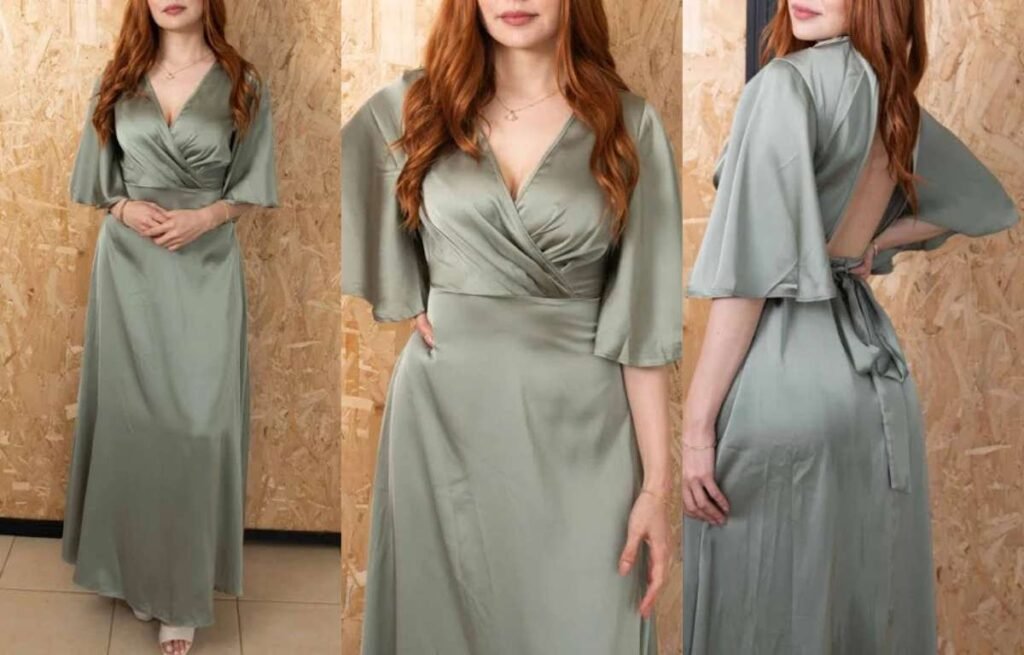
Why is the bias cut sleeve a refined choice in women’s fashion design?
It may seem technical, but bias cut sleeves bring surprising fluidity and fit to garments.
Bias cut sleeves are made by cutting fabric diagonally across the grain, allowing more natural stretch and drape. This creates sleeves that contour gracefully to the arm and move with the body, often seen in elegant, flowy designs.
How does the bias cut sleeve differ from straight-grain sleeve construction?
Grainline direction changes everything in sleeve behavior.
Unlike standard sleeves cut along the straight or cross grain, bias cut sleeves follow a 45° angle, which introduces gentle elasticity and a softer fall. This technique reduces stiffness and improves movement.
The difference is subtle in appearance but significant in how the sleeve feels and performs—especially in premium fabrics.
The Technical and Design Value of Bias Cut Sleeves
To truly understand this sleeve type, let’s examine its structural and functional advantages.
1. Fabric Behavior on the Bias
- Natural Stretch Without Elastane
Bias cuts introduce give even in non-stretch fabrics like silk or crepe.
This allows for fitted sleeves without tightness, making it ideal for formalwear or elevated everyday styles. - Drape and Flow
Sleeves hang more softly when bias-cut, especially around the elbow and wrist.
Movements appear more fluid, making this cut popular in eveningwear and luxury blouses.
2. Sleeve Fit and Silhouette
- Contours the Arm Gracefully
Bias cut sleeves hug the arm slightly but don’t cling.
The shape often tapers gently, enhancing a slim and polished profile. - Reduces Bulk at Seams
Especially when using fine fabrics, bias cutting allows cleaner seam finishes due to the way fabric behaves.
3. Best Fabric Matches
- Works best with drapey, lightweight fabrics:
- Silk charmeuse
- Rayon
- Crepe de chine
- Lightweight satin
- Not ideal for heavy or stiff materials like canvas or denim—they don’t flow or hold the stretch benefit as well.
4. Common Garment Applications
| Garment Type | How Bias Cut Sleeve Elevates Design |
|---|---|
| Silk Blouses | Adds movement and softness |
| Evening Dresses | Enhances elegance and visual fluidity |
| Wrap Dresses | Complements bias-cut body panels seamlessly |
| Bridalwear | Offers softness and natural drape without bulk |
5. Challenges and Production Notes
Skill Level
Sewing bias sleeves requires experienced handling—without it, seams may warp or distort during construction.
Pattern Placement Matters
Bias cut uses more fabric, which affects yield and production cost.
Seam Stability Required
Edges need to be stay-stitched or reinforced, as bias cuts may stretch out over time.
Shoulder Cut-out Sleeve

Why are shoulder cut-out sleeves a trending detail in women’s fashion design?
This sleeve shows just enough skin to be bold but wearable.
Shoulder cut-out sleeves—also known as cold shoulder sleeves—feature a visible gap or cut at the shoulder area. They balance modesty with allure, making them a popular choice in contemporary women’s fashion.
What defines a shoulder cut-out sleeve, and how is it constructed?
It’s all about controlled exposure and deliberate placement.
A shoulder cut-out sleeve is created by removing or separating fabric at the shoulder while keeping the rest of the sleeve intact. The cut-out may be rounded, angular, or framed with trims or ties.
Designers often reinforce the cut-out area with binding or facing to keep its shape after washing and wear. It’s not just decorative—it affects structure.
Design Value and Strategic Use of Shoulder Cut-outs
1. Aesthetic Balance: Modesty vs. Allure
Shoulder cut-outs work because they reveal skin in a controlled, minimal way. Compared to plunging necklines or open backs, shoulder reveals are more versatile for daytime looks while still catching attention.
- For younger demographics, it taps into the “sexy-but-chill” aesthetic.
- For mature consumers, it offers a modern twist without being too revealing.
2. Placement Strategy & Symmetry
Where and how much of the shoulder you expose matters. Common styles include:
- Classic cold shoulder: symmetrical round or oval openings.
- One-shoulder cut-out: asymmetrical, often paired with draped sleeves.
- Slit-based cut-outs: long vertical slits along the shoulder seam, often used in elevated streetwear or minimal designs.
3. Material Compatibility
Some fabrics work better than others for shoulder cut-outs:
- Stable knits (e.g., ribbed cotton) hold the shape well.
- Wovens with structure (like crepe or poplin) give clean cuts without sagging.
- Avoid slippery materials like satin unless reinforced, as they may distort the cut-out over time.
| Fabric Type | Suitability | Notes |
|---|---|---|
| Ribbed jersey | ✅ | Great stretch and shape retention |
| Linen blend | ✅ | Good structure with breathability |
| Satin | ⚠️ | Needs careful reinforcement |
4. Style Application
Shoulder cut-out sleeves show up across multiple categories:
- Tops: From casual tees to high-street blouses.
- Dresses: Bodycon, shift, and boho styles alike use this detail.
- Sweaters: Especially in lightweight yarns for spring/fall.
It’s a flexible design that elevates basic silhouettes without requiring heavy embellishment.
Structured Shoulder Sleeve
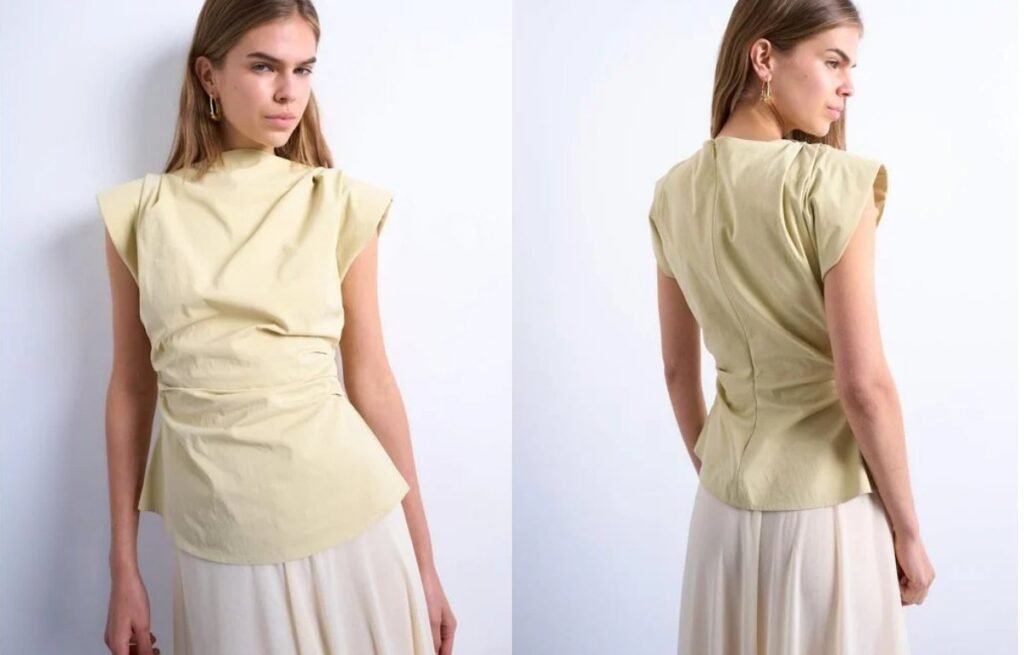
Why are structured shoulder sleeves a signature element in bold women’s fashion?
Structured shoulders are everywhere in runway looks and modern high-street designs—they demand attention.
Structured shoulder sleeves use padding, interfacing, or sharp construction to emphasize the shoulder line, creating strong and confident silhouettes. They’re widely used in blazers, coats, and directional tops.
How are structured shoulder sleeves different from standard shoulder constructions?
These sleeves don’t just attach to the garment—they define the whole upper-body impression.
Structured shoulder sleeves rely on shoulder pads, angular sleeve cuts, and rigid fabrics to form a bold shoulder shape. Unlike soft or dropped shoulders, they give structure, authority, and style definition.
They’re not just for officewear—many fashion brands now use them to reference retro, Y2K, or even futuristic aesthetics.
Common structural techniques:
- Built-in shoulder pads
- Sharp sleeve cap shaping
- Strong interfacing and linings
- Clean, angular armhole construction
Which types of garments benefit most from structured shoulder sleeves?
These sleeves work best when the goal is visual structure and impact.
Structured shoulders are ideal for blazers, cropped jackets, tailored dresses, and power tops. They transform simple shapes into bold, defined silhouettes.
I once developed a collection of structured wool outerwear for an emerging brand targeting independent women. It performed especially well in Western markets.
Best-use garments:
- Double-breasted blazers
- Cropped, square-cut jackets
- Shoulder-padded knits
- Sleek power dresses and jumpsuits
How do structured shoulder sleeves shape body proportions and design impact?
This is where structure becomes strategy—it’s about shaping perception.
Structured shoulders manipulate proportions to visually widen the upper body, slim the waistline, and create a stronger silhouette. They can turn even a basic outfit into a statement.
Design Techniques and Strategic Use
1. Padding Levels and Function
- Soft padding → Adds elegance without bulk
- Medium padding → Perfect for balance and formality
- Hard or extended padding → Used for high-fashion, editorial edge
2. Seam and Cut Strategy
- Princess seams flowing into the shoulder accentuate shape
- Armholes are cut at a steeper angle, creating lift and presence
- Sleeve caps are shaped to stand or lift for extra volume
3. Fabric Compatibility
| Fabric Type | Purpose |
|---|---|
| Wool blends | Strong tailoring structure |
| Scuba/Ponte | Clean shaping with stretch |
| Canvas/Twill | Holds angular lines in jackets |
| Knit + fusible | Adds firmness without stiffness |
4. Styling Considerations
- Balance bold shoulders with fitted or high-waist bottoms
- Avoid pairing with wide-leg or loose shapes unless styling for editorial impact
- Shoes matter—heels or boots elevate the whole frame
5. Cultural & Trend Influence
The return of power shoulders reflects post-pandemic values—confidence, control, presence
Structured sleeves echo 1980s fashion, now reborn in techwear, digital collections, and luxury labels
Feather Sleeve
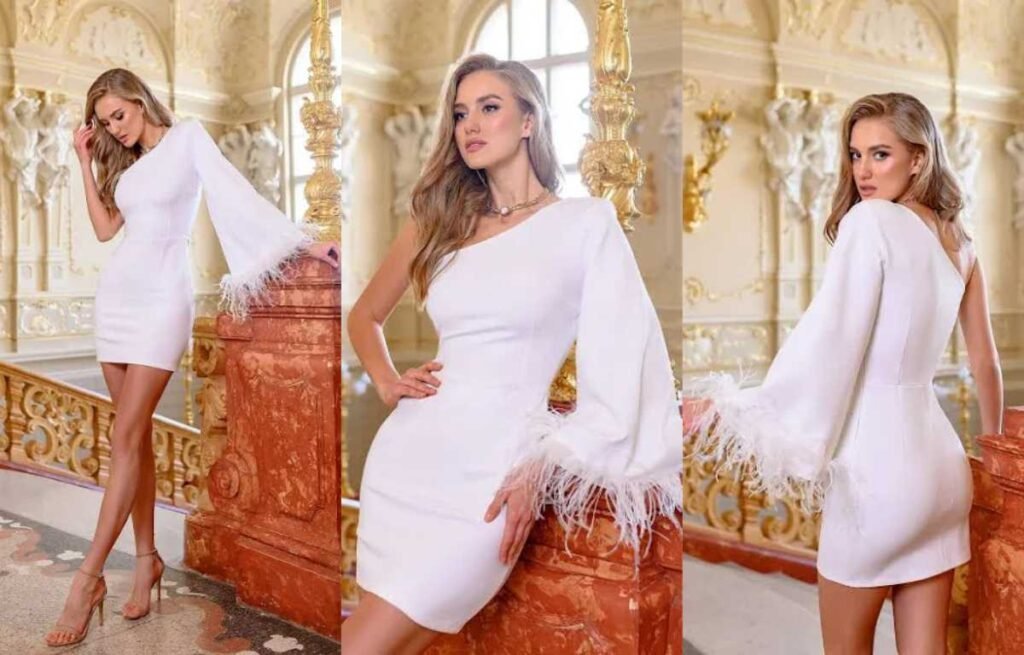
What makes the feather sleeve a standout choice in women’s fashion design?
Feather sleeves catch the eye—they’re delicate but unforgettable.
Feather sleeves feature soft, airy layers that mimic the lightness of feathers. These layers flutter beautifully with movement, adding both texture and a dramatic accent without heavy structure.
I once created a motion-focused evening dress where the feather sleeves became the signature element—floating with every step and instantly elevating the overall look.
How are feather sleeves typically constructed?
Construction affects both the look and functionality of a sleeve.
Feather sleeves are usually built with layered strips of fabric—like chiffon, organza, or actual trimmed feathers—attached in rows or clusters. Each layer overlaps subtly for a textured, multidimensional effect.
To keep the style light, I often use sheer textiles or lightweight faux feathers. The way those layers are placed impacts movement and how light plays off them.
Key structural notes:
| Element | Feather Sleeve Detail |
|---|---|
| Layering method | Horizontal tiers, clusters, or scalloped bands |
| Base fabric support | Lightweight mesh or tulle for transparency |
| Trim/fabric options | Real feathers, feather-like fringe, lightweight tulle |
| Attachment style | Sewn bands, clipped trim, hand-applied placement |
Why use feather sleeves? What’s their design impact?
Adding feather sleeves is more than decoration—it’s a design statement.
Feather sleeves introduce luxurious texture, movement, and volume. Their airy nature ensures drama without weight, making them ideal for special occasions where the wearer wants elegance with motion.
They often turn a simple silhouette into something memorable and ethereal—especially effective in bridal, red-carpet, and high-fashion contexts.
Designing with Feather Sleeves in a Professional Context
Here’s a closer, more strategic look at how to use feather sleeves with intention:
1. Concept & Mood Alignment
- Mood board and garment vision — Feather sleeves are perfect when the design concept includes ethereal, whimsical, or haute couture elements. For minimalist pieces, they may feel out of place.
- Occasion relevance — Ideal for fashion-forward eveningwear, bridal, or couture; less suitable for casual or everyday wear due to their embellishment-focused nature.
2. Fabric & Weight Management
- Lightweight support structure — Use delicate mesh, tulle, or sheer silk as a base. This ensures the feather elements don’t weigh the sleeve or distort the garment.
- Material selection — Choose between actual feathers (like ostrich or marabou), eco-friendly faux memory feathers, or feather-inspired fringes—each offers a distinct aesthetic and care profile.
3. Movement & Silhouette Interaction
- Layer placement matters — Horizontal tiers create a cascading ripple effect; clustered placement yields concentrated drama at key zones like shoulders or cuffs.
- Balance with silhouette — Feather sleeves add volume; pairing them with streamlined bodices or minimal skirts helps maintain shape harmony.
4. Technical Feasibility & Durability
- Attachment technique — Hem band stitching provides structure, while hand-applied layers offer customization but require more time and precision.
- Wearability concerns — Consider garment strength at the shoulder seam, clean handling without shedding (for real feathers), and transport or care—especially in long-sleeve designs.
5. Cost & Ethical Considerations
- Production cost — Feather detailing adds labor and material expense. Using faux feathers or fringe trims can reduce cost while maintaining visual impact.
- Ethical sourcing — Real feathers may raise animal welfare concerns. Choosing cruelty-free or vegan alternatives aligns with sustainable or ethical fashion practices.
Feather sleeves bring textural luxury, dynamic movement, and artistic flair to women’s fashion. When designed thoughtfully—considering fabric, structure, silhouette, sustainability, and cost—they become unforgettable elements that elevate special-edition pieces or couture designs.
Mesh Puff Sleeve

Why is the mesh puff sleeve a staple in contemporary women’s fashion design?
It’s airy, bold, and visually striking—but still light and wearable.
Mesh puff sleeves combine volume with transparency, delivering a modern statement that balances drama and delicacy. They are often used to elevate simple silhouettes with a touch of high-fashion flair.
What makes the mesh puff sleeve different from other puff sleeve styles?
It’s the fabric that changes everything.
Unlike cotton or satin puff sleeves, mesh versions add structure without heaviness. The sheer fabric holds volume while creating visual lightness, making the sleeve look bold yet breathable.
Designers often use stiffened tulle, organza, or power mesh to maintain the shape of the puff while still offering transparency and movement.
Understanding the Design Potential of Mesh Puff Sleeves
To fully explore this sleeve style, we need to break down its key technical and aesthetic components:
1. Fabric Choice and Structural Impact
Mesh fabrics can vary widely in stiffness, stretch, and opacity. Choosing the right mesh is crucial for maintaining the puff effect:
| Fabric Type | Transparency | Structure | Stretch | Ideal Use |
|---|---|---|---|---|
| Tulle | High | Medium | None | High-volume puff sleeves |
| Organza | Medium | High | None | Structured, elegant looks |
| Power Mesh | Medium | Low | High | Sporty or fitted puff tops |
- Tulle and organza are often used for exaggerated sleeve shapes in occasionwear.
- Power mesh works well for contemporary, body-conscious designs with volume on the upper arm only.
2. Pattern Drafting Techniques
To create a successful mesh puff sleeve, the pattern must:
- Include generous gathers or pleats at the cap and hem
- Be drafted wider than regular sleeves to allow for volume
- Often include elastic cuffs or sleeve bands to trap air and maintain puffiness
3. Design Application & Balance
Because mesh puff sleeves carry strong visual weight, they must be balanced with simpler garment bodies. Here are common styling approaches:
- Contrast Pairing: Match mesh puff sleeves with sleek fitted dresses or minimalist tops
- Tone-on-Tone Textures: Use tonal colors but mix materials for subtle depth
- Layered Transparency: Layer mesh sleeves over nude linings or bralettes for an editorial look
4. Target Customer and Market Fit
This sleeve type appeals to:
- Gen Z and younger Millennials seeking fashion-forward, Insta-ready looks
- Occasionwear and trend-led brands that emphasize silhouette play
- Brands with seasonal collections (especially spring/summer)
What should you avoid when designing or sourcing mesh puff sleeves?
Balance is everything—overdo it, and it can look costume-y.
Avoid overly stiff mesh that doesn’t move, or thin mesh that collapses. Also, beware of poor seam finishing—exposed mesh edges can fray or irritate.
When I first sourced mesh sleeves years ago, I made the mistake of choosing ultra-fine tulle without reinforcement—it collapsed after two wears. Lesson learned.
Leather Sleeve
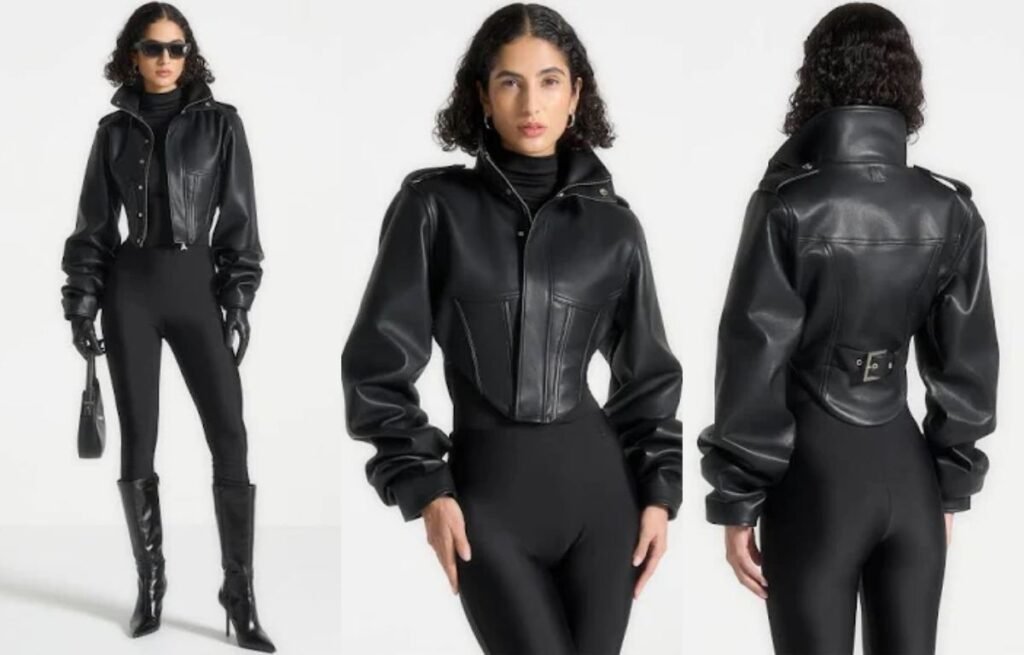
What defines a leather sleeve in women’s fashion design?
Leather sleeves bring instant edge—but when done right, they also signal luxury, strength, and intentional style.
Leather sleeves—whether in jackets, dresses, or blouses—combine tactile richness, sculptural structure, and visual impact. They elevate garments with their texture, weight, and sheen.
I remember adding leather sleeves to a soft knit dress—it instantly transformed a cozy piece into a bold, confident statement.
What are the main construction and styling features of leather sleeves?
Leather is unforgiving, so its sleeve patterns must be precise.
Leather sleeves are often tailored with sharp seams and minimal bulk to maintain clean lines. They typically require lining and are stitched carefully to prevent puckering or stiffness. Whether fitted or slightly relaxed, the finish speaks of craftsmanship.
In a leather moto jacket project, I learned that even a half-millimeter misalignment in the sleeve seam stood out—precision matters.
Key design traits:
- Precise seam work with minimal ease
- Lined interiors for comfort
- Options: fitted tubing, slightly structured blouson, or ruched scrunch style
What fabrics and finishes elevate leather sleeve design?
Choosing the right leather type makes all the difference.
Smooth lambskin and buttery sheepskin drape beautifully for sleek, elegant sleeves. For structured looks, pebbled cowhide or suede adds texture and weight. Finish—matte, glossy, or distressed—changes how the sleeve reads in the broader design.
In one client sample, distressed cowhide for a curved sleeve gave a vintage rocker vibe; swapping to lambskin made it look refined and luxe.
Recommended leather types:
- Soft drape: Lambskin, sheepskin
- Textured/edged: Pebbled cowhide, suede, mock croc
- Finish styles: Matte, high gloss, distressed
Why do leather sleeves require special design and tailoring techniques?
Leather behaves differently than woven or knit fabrics; that changes everything.
Leather does not stretch or fray easily, so you must pre-fit everything. Seam allowances must account for thickness, you need strong thread and lining, and the leather must flex when worn, so cuts must match movement zones like elbows.
I once had to redo a leather dress sleeve entirely because I didn’t allow movement ease at the elbow. After adding a slight gusset, it fit perfectly.
Professional Insights into Leather Sleeve Design
1. Patterning with Substance
When working with leather, every millimeter counts. Leather can’t stretch to accommodate fit issues. Designers must pattern with accurate anatomical reference points—especially at the elbow and underarm zones—to guarantee clean movement without creases or stress marks.
2. Lining for Comfort and Shape
Leather sleeves almost always need lining—ideally in a slippery satin or twill—to help them slide over other clothing and prevent sweating or irritation. The lining can also offer subtle shaping support or hide internal structure like darts or reinforcements.
3. Visual Language: Texture as Statement
Leather isn’t just a material—it’s a visual signature. A smooth sleeve whispers elegance, while suede or buttery pebbled hides hint at grit or bohemian cool. Designers can also combine leather sleeve panels with other textures (knit body, printed fabric) to create contrast and layered storytelling.
4. Functional Durability
Unlike delicate glossy fabrics, leather sleeves must endure real wear—zipper pulls, elbow bends, and abrasion. Reinforcing high-wear areas like elbows or shoulder seams ensures longevity. Glossy finishes may require surface protection. Designers must balance aesthetics with resilience.
Organza Sleeve
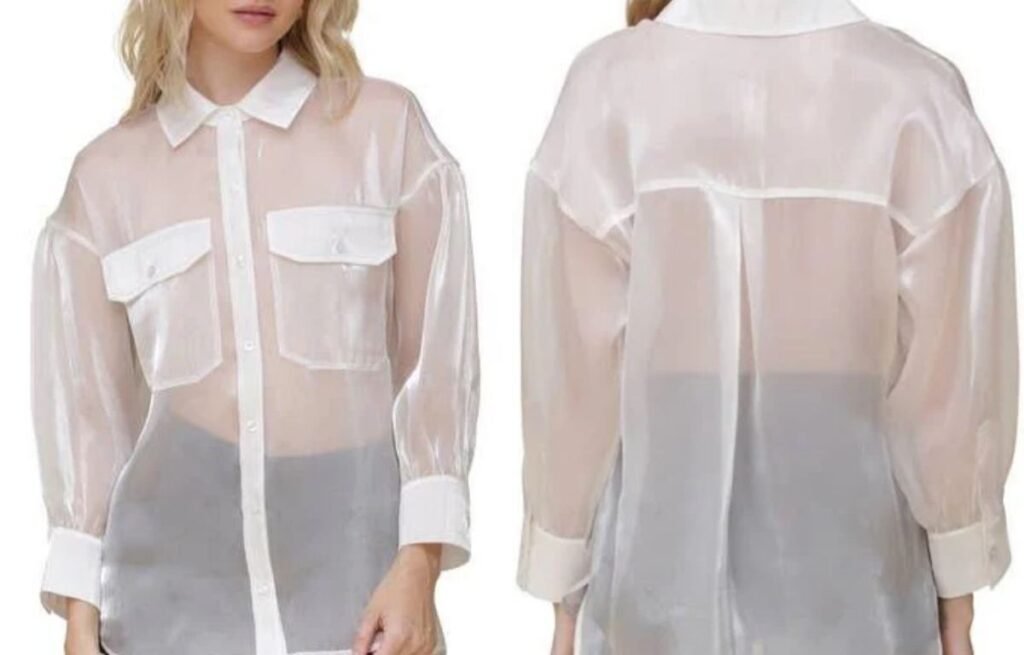
What makes organza sleeves a signature element in women’s fashion design?
Organza sleeves aren’t just sheer—they’re strategic.
Organza sleeves use their semi-transparency, stiffness, and sculptural texture to create drama, elegance, and lightness. They’re often used in eveningwear and statement tops to enhance femininity without adding bulk.
What defines an organza sleeve beyond the fabric itself?
It’s not just about the sheer look—it’s how the sleeve behaves on the body.
Organza sleeves are made from a crisp, lightweight woven fabric that holds shape. This allows for exaggerated silhouettes—like puff, balloon, or ruffle sleeves—while maintaining lightness and breathability.
Unlike chiffon or mesh, organza doesn’t drape softly. It stands away from the body, creating volume that feels structured, even when layered or gathered.
How to design and use organza sleeves effectively
Designing with organza sleeves isn’t only about picking a sheer fabric—it’s about balancing aesthetics, structure, and technical execution.
1. Sleeve Structures That Maximize Organza’s Qualities
Because of its stiffness, organza is ideal for sleeves that require volume:
- Puff sleeves – Retain volume without sagging
- Layered ruffle sleeves – Hold shape and float with motion
- Balloon sleeves – Create drama, especially with cuffs
- Bishop sleeves with elastic cuffs – Balance lightness and fullness
These silhouettes stay crisp even after hours of wear—unlike softer fabrics that collapse.
2. Best Pairings: Where Organza Sleeves Shine
Organza sleeves aren’t for every garment. They’re most effective when paired with:
- Eveningwear dresses – Add light drama and feminine silhouette
- Statement blouses – Perfect for eventwear or trend-driven fashion
- Bridalwear – Softens structure with sheer volume
- Minimalist bodies – To let the sleeve take visual center stage
| Garment Type | Why Organza Works |
|---|---|
| Evening dress | Light, elegant, adds sculptural drama |
| Bridal gowns | Airy yet defined for a romantic feel |
| Fashion tops | Trend-forward, sheer with shape |
| Jumpsuits | Unexpected contrast to tailored bodies |
3. Layering and Lining Techniques
Because organza is transparent, designers must decide what goes beneath it:
- Double-layer organza for more defined color and opacity
- Contrast lining to enhance visual effect (e.g. black lining with white organza)
- Unlined sleeves to reveal skin for sensuality
- Panel blocking to combine with solid fabrics for contrast
A client once wanted maximum sleeve volume but a “light” look—I used double organza with a skin-tone lining and the result was both bold and ethereal.
4. Construction Considerations
Organza is beautiful—but tricky to sew:
- Frays easily – seams must be finished properly (French seams, bias binding)
- Can crease – needs careful handling during pressing
- Stiff edges – can irritate the skin; soft seam finishes are important
For high-end clients, I always recommend lining the inside of cuffs or armscye with cotton tape or binding for comfort.
Adjustable Strap Sleeve
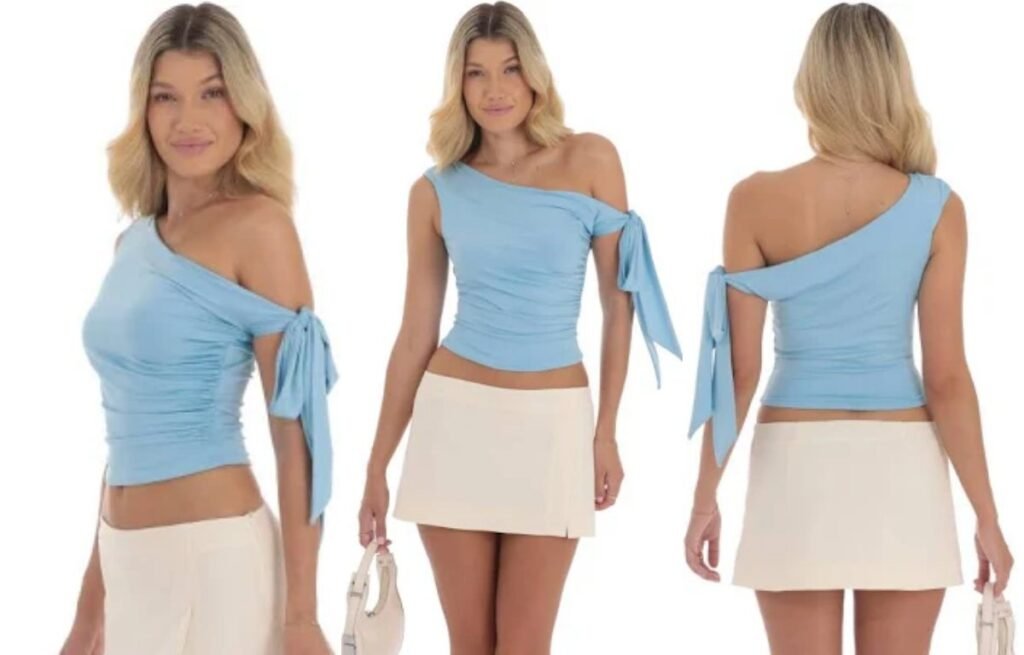
Why is the adjustable strap sleeve a key detail in modern women’s fashion?
It’s a small detail—but it shapes both fit and fashion expression.
Adjustable strap sleeves allow the wearer to modify the strap length, improving comfort and versatility. They’re especially common in camisoles, slip dresses, and summer tops, offering both practicality and style.
I once had a client complain about ready-to-wear camisoles always being too long. We switched to adjustable straps, and her customer repurchase rate shot up.
What makes adjustable strap sleeves different from fixed straps?
Not all straps deliver a truly personalized fit.
Adjustable strap sleeves use a slider or buckle—usually plastic or metal—sewn into the strap, allowing the wearer to adjust the fit over the shoulders. Fixed straps lack this flexibility.
This detail is especially valuable for a wide range of body types, particularly in basics where comfort is a top priority.
Core comparison:
| Feature | Adjustable Strap Sleeve | Fixed Strap Sleeve |
|---|---|---|
| Adjustable? | Yes | No |
| Fit flexibility | High | Limited |
| Body type adaptability | Broad | Restricted |
| Common usage | Camisoles, slips, lingerie | Tank tops, designer straps |
What materials and styles best support adjustable strap sleeves?
The structure and fabric need to complement the adjustability.
Thin yet strong materials like satin ribbon, nylon tape, or elastic blends are ideal for adjustable straps. The hardware—sliders and rings—should be lightweight, sturdy, and color-matched for aesthetic consistency.
I recommend pairing medium-weight fabrics for the body of the garment with durable strap materials to ensure the straps don’t stretch or snap during washing or wearing.
Material suggestions:
- Strap materials: Satin ribbon, nylon webbing, spandex blends
- Hardware options: Plated metal sliders, matte plastic rings
- Best garment types: Adjustable camis, intimatewear, versatile dresses
How do adjustable strap sleeves enhance garment fit and brand value?
Design isn’t just about style—it’s about smart fit solutions.
Adjustable straps reduce return rates due to poor fit and increase perceived garment value. Customers associate adjustability with personalization and comfort.
Especially in online fashion, buyers worry about sizing. Adjustable features solve this issue directly. One brand I work with consistently gets higher ratings when adjustability is included in strap-based garments.
Why adjustable straps are more than just a trend
Let’s explore the impact from design, production, and user perspectives.
1. Design Perspective: Fit for diverse body shapes
- Different shoulder widths and bust sizes require different strap lengths. Adjustable straps create a near-customized feel.
- Ideal for global markets, especially for small-batch exports to Western customers.
2. Production Perspective: Material sourcing and quality control
- During manufacturing, consistent supply of sliders and strap materials is crucial—color matching matters.
- Pro tip: Use locking sliders to prevent straps from slipping; include extra adjusters in bulk shipments for replacements.
3. User Experience: Boost satisfaction, reduce returns
- Adjustable features give users a sense of control over fit, increasing satisfaction.
- On e-commerce platforms, this detail often draws the line between a five-star review and a return request.
Petal Flare Sleeve

What makes the petal flare sleeve a feminine standout in modern fashion?
Petal flare sleeves look light and simple, but they add instant elegance.
A petal flare sleeve overlaps two curved pieces of fabric, mimicking flower petals. The flared shape brings movement and softness to the arm, making it ideal for romantic, feminine styles.
I once designed a bridesmaid dress using petal sleeves—it was the most photographed style in the entire collection.
How is the petal flare sleeve constructed differently from other sleeve types?
It’s all about the overlap and curve.
Unlike straight-cut sleeves, the petal flare sleeve is built with two or more curved panels that overlap at the upper arm. This construction gives the illusion of petals opening and allows more freedom of motion.
It’s a favorite among designers who want flow and grace without using too much volume.
Key Construction Elements:
- Overlapping curved panels
- Usually unlined or single-layer for movement
- Attached at armhole with little to no underarm seam
- Can be short or mid-length, commonly seen on blouses and dresses
Why does this sleeve type work so well for soft, romantic silhouettes?
It’s all about the balance between structure and fluidity.
The sleeve’s open, fluttering shape echoes floral forms and complements drapey materials like chiffon or rayon. It softens sharp angles and flatters the arms by not clinging.
You’ll often see it used in bridalwear, spring collections, and minimalist brands aiming for elegance without clutter.
The Design Strategy Behind Petal Flare Sleeves
To truly understand this sleeve, let’s explore its design logic from multiple angles:
1. Visual Effect & Silhouette Control
- Petal sleeves work like visual breaks—they cut diagonally across the bicep, which helps:
- Slim the upper arm
- Draw attention to the sleeve movement, not arm width
- Create a gentle V-shape that’s flattering on most body types
2. Fabric Pairing for Flow
- This sleeve needs fluid fabrics that drape well but don’t bulk up:
- Best choices: chiffon, rayon, georgette, crepe
- Avoid: stiff cottons, thick knits—they disrupt the petal flow
| Fabric | Effect on Petal Sleeve |
|---|---|
| Chiffon | Airy, transparent, romantic |
| Rayon | Drapey and soft-touch |
| Georgette | Textured and light |
| Silk Crepe | Luxurious and structured flow |
3. Ideal Garment Placement
- Works best on:
- Blouses, wrap tops, peasant blouses
- Bridal or bridesmaid dresses
- Summer or vacation dresses
- Tunic tops for casual feminine looks
4. Limitations and Fit Considerations
May expose underarms if not correctly aligned—should be tested in sample stage
Not suitable for cold-weather wear
Needs careful finishing to avoid frayed edges
Less effective on very structured or fitted garments
Looped Bow Sleeve
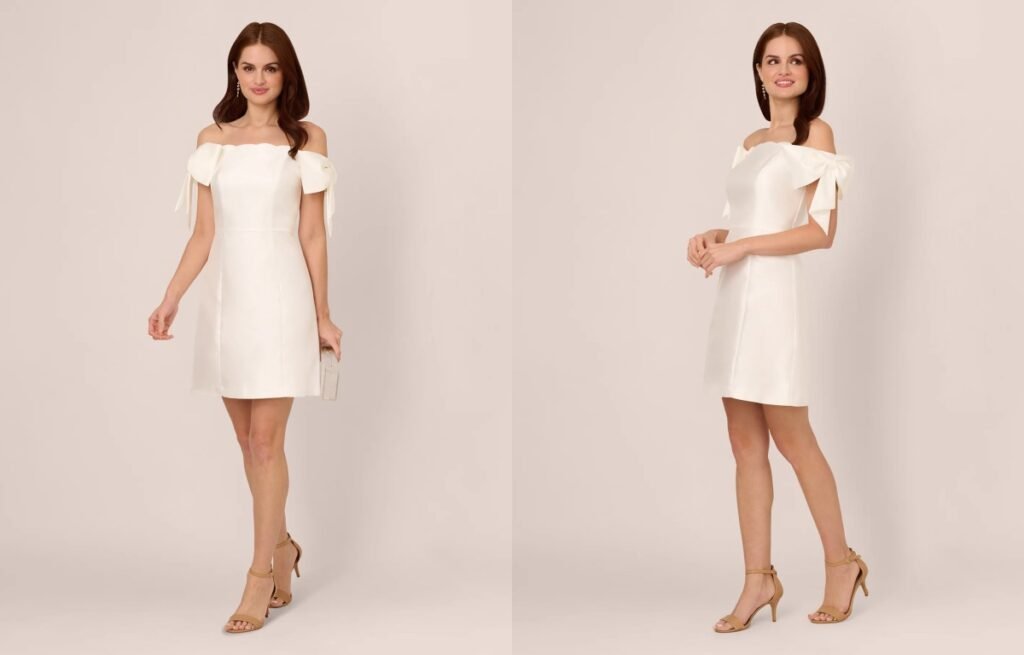
Why is the looped bow sleeve a rising favorite in modern women’s fashion?
Looped bow sleeves might seem decorative, but they carry real design weight.
A looped bow sleeve features fabric loops tied into bows—usually positioned at the cuff or upper sleeve—bringing a playful yet elegant detail. It adds a touch of femininity and visual interest without needing prints or bold colors.
What defines a looped bow sleeve compared to other statement sleeves?
It’s more than just tying a ribbon—it’s part of the sleeve construction.
Unlike external accessories, the looped bow is often built from the sleeve fabric itself, shaped into loops and sewn into place. This design is not removable and becomes an integrated part of the garment’s style and silhouette.
The bow may be functional (adjustable opening) or purely decorative, and can be scaled from subtle to oversized depending on the brand aesthetic.
Key comparisons:
| Feature | Looped Bow Sleeve | Puff/Bell Sleeve |
|---|---|---|
| Focus | Decorative bow detail | Volume and shape |
| Structure Integration | Built into sleeve seam | Volume added through pleats |
| Aesthetic Vibe | Romantic, delicate | Bold, theatrical |
| Common Garment Use | Blouses, dresses, tops | Eveningwear, street style |
How can the looped bow sleeve enhance garment design beyond just decoration?
It’s not only pretty—it creates focus and direction in design.
Looped bow sleeves draw attention to the arms and cuffs, subtly guiding the viewer’s eye across the garment. This detail balances minimal designs, creates movement, and enhances brand identity for labels targeting feminine or Gen Z aesthetics.
I often recommend it for collections aiming for soft power—something romantic but not overly formal.
What are the design, technical, and branding implications of looped bow sleeves?
Let’s break down why this detail matters from a designer’s and buyer’s perspective:
1. Design Identity and Brand Language
- Visual storytelling: The bow creates an emotional and playful association—ideal for brands speaking to youthful, romantic, or Korean/Japanese fashion aesthetics.
- Signature detail potential: A unique bow placement or shape can become a signature element for a brand.
2. Technical Construction
- Pattern making: Requires precision in drafting bow dimensions and their placement to avoid bunching or imbalance.
- Fabric compatibility: Best suited to medium-weight fabrics with structure—poplin, taffeta, crepe—that hold the bow shape without sagging.
- Finishing methods:
- Self-fabric loops or contrast fabric can be used.
- Bows can be stitched down or left partially loose for movement.
3. Wearability & Fit
- Pros:
- Adjustable options can improve sleeve flexibility.
- Adds design interest without compromising comfort.
- Cons:
- Risk of bulk if poorly placed.
- May not layer well under outerwear.
4. Product Differentiation
- In a crowded blouse market, a sleeve like this helps differentiate SKUs.
- Ideal for:
- Romantic spring/summer drops
- Content-friendly fashion (great for social media and photo shoots)
- Occasionwear or lifestyle-focused e-commerce brands
5. Styling Considerations
Minimal accessories to avoid over-styling
Works best when the rest of the garment is clean and simple.
Pair with:
Tapered or straight trousers
A-line or pencil skirts
Slit Flare Sleeve
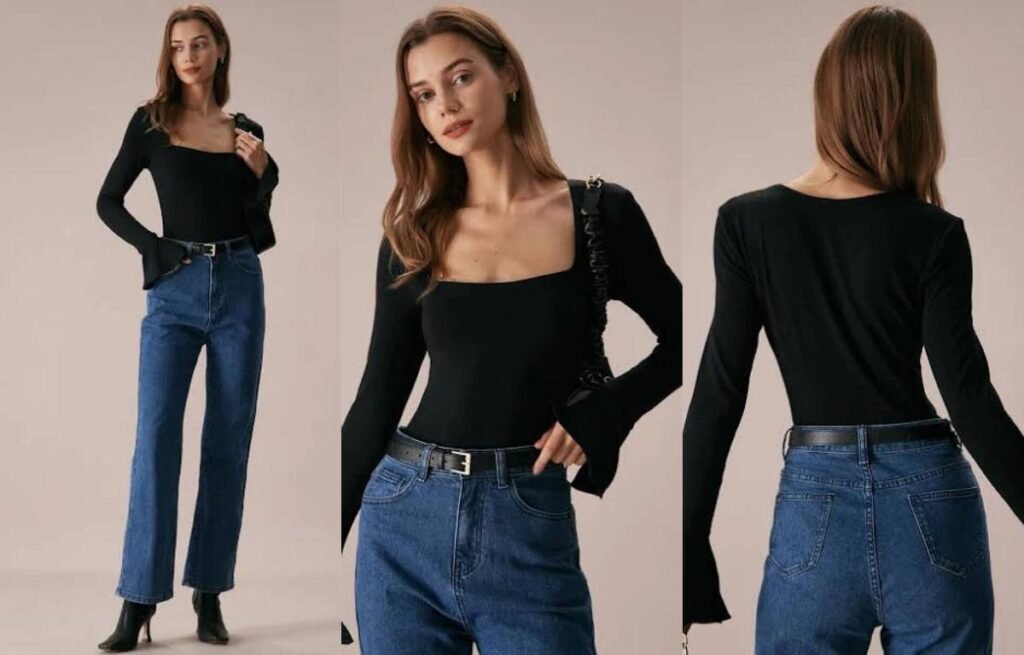
Slit Flare Sleeve: A Subtle Yet Dramatic Twist
The Slit Flare Sleeve is an elegant sleeve design that combines softness with a touch of drama, giving garments a sophisticated yet modern feel.
This sleeve features a flare from the elbow or wrist, with a slit that runs vertically through the sleeve, allowing for movement and an added visual interest. The slit can vary in size, either being subtle or more pronounced, depending on the intended style. Slit flare sleeves are often used in boho-chic, evening wear, and high-fashion collections.
Why is the Slit Flare Sleeve so Popular in Modern Fashion?
The slit flare sleeve is loved for its balance between subtlety and statement-making impact.
It creates a delicate, flowing silhouette that allows the wearer to move gracefully while still standing out. The addition of the slit introduces an element of asymmetry that feels dynamic and modern, making it ideal for both casual and formal outfits.
Analyzing the Appeal of the Slit Flare Sleeve
The Slit Flare Sleeve is a design that blends softness and movement with a refined structure. It may appear simple at first glance, but it holds significant potential in fashion design. Here’s a closer look at the elements that make this sleeve type stand out:
- Sophisticated Movement and Flow:
The flare in the sleeve adds fluidity to the garment, which, when combined with the slit, allows the wearer to move freely. This movement is both graceful and dramatic, making the sleeve perfect for garments that are designed to flow with the body, like dresses or blouses. The slit accentuates the natural motion of the arms, making the sleeve more dynamic. - Play with Asymmetry:
One of the defining features of the slit flare sleeve is the asymmetry created by the slit. While the flare provides fullness and volume, the slit breaks up the solid form, adding a contemporary, slightly deconstructed feel. This is especially appealing in modern fashion, where minimalism and unexpected design elements are often favored. - Flattering for Various Body Types:
The slit flare sleeve is versatile in terms of how it flatters different body shapes. The flare adds volume at the wrist or elbow, which helps balance out the proportion for those with narrower shoulders or hips. For individuals with broader shoulders or an inverted triangle shape, the volume created by the flare can soften the shoulder line and add balance. - Fabric Versatility:
The slit flare sleeve works well with a variety of fabrics, which can alter the look and feel of the design. Lightweight fabrics like chiffon or silk allow for a soft, ethereal movement, while more structured fabrics such as cotton or taffeta give the sleeve a more crisp, sculpted look. The fabric choice will influence the degree of flare and how dramatic the slit appears. - Suitable for Both Casual and Formal Wear:
The beauty of the slit flare sleeve is its versatility. For a casual, bohemian-inspired look, the flare and slit can be made from soft, flowing fabrics that enhance the laid-back feel. On the other hand, when crafted in luxurious fabrics such as silk or velvet, the slit flare sleeve can be turned into a high-fashion design element, perfect for evening wear or couture collections.
Structural Features of Slit Flare Sleeves:
- Flare: The sleeve gradually widens from the elbow or wrist, adding volume and drama.
- Slit: A vertical opening that cuts through the fabric of the sleeve, usually starting at the wrist or elbow. The slit may be a modest opening or extend further for a bolder statement.
- Length and Shape: The length of the flare can vary, with some designs flaring only slightly, while others are more dramatic and wide.
Slit Flare Sleeve vs. Other Flared Sleeve Styles
| Feature | Slit Flare Sleeve | Bell Sleeve | Trumpet Sleeve |
|---|---|---|---|
| Structure | Flare with a slit | Full flare, no slit | Fitted at the top, flares out at the bottom |
| Aesthetic Effect | Subtle and sophisticated | Soft, romantic | Dramatic and bold |
| Ideal Occasions | Bohemian, evening wear | Casual, vintage looks | Formal, evening wear |
| Fabric Compatibility | Works with both light and structured fabrics | Works best with lightweight fabrics | Best with stiffer fabrics |
Best Fabrics for Slit Flare Sleeves
The fabric used for a slit flare sleeve can greatly influence the overall effect and flow of the design. Here are some fabric options that work well:
- Chiffon: Adds a light, airy feel and enhances the movement of the flare.
- Silk: Provides a luxurious, fluid drape, ideal for evening wear.
- Cotton: Offers a more structured flare, giving the sleeve a crisp finish.
- Taffeta: A stiffer fabric that creates a more pronounced flare and structured look.
- Velvet: Adds depth and texture, creating a rich, dramatic look for formal or evening wear.
How to Style Slit Flare Sleeves
When styling garments with slit flare sleeves, it’s important to balance the volume in the sleeves with more fitted pieces for the rest of the outfit. Pair a slit flare sleeve blouse with tailored trousers or a sleek pencil skirt to keep the silhouette balanced. For evening wear, opt for a dress or top in rich fabrics like velvet or silk to emphasize the luxurious feel of the design.
Keep accessories minimal to allow the sleeve to take center stage, with simple earrings or a delicate bracelet complementing the look.
Layered Cage Sleeve

Layered Cage Sleeve: A Bold, Sculptural Design
The Layered Cage Sleeve is one of the most striking sleeve styles in modern fashion, known for its bold, multi-dimensional look.
It features layers of fabric or mesh arranged in a cage-like structure, creating a dramatic, sculptural effect. This sleeve adds volume and texture, making it ideal for fashion-forward pieces, evening wear, and avant-garde designs.
Why Are Layered Cage Sleeves So Popular?
Layered cage sleeves are a perfect example of how a sleeve can transform a garment.
They turn a simple garment into an eye-catching design piece, whether it’s a blouse, dress, or jacket. The layered effect plays with light and shadow, adding depth and movement while maintaining a structured appearance.
Analyzing the Appeal of Layered Cage Sleeves
Layered cage sleeves are more than just decorative—they serve both aesthetic and practical purposes:
- Architectural Design: The layers mimic architectural principles, creating a dynamic and sculptural look that adds depth to a garment.
- Movement and Texture: These sleeves add a sense of motion as the wearer moves, thanks to the slight separation between layers, which gives the garment a more dynamic feel.
- Versatility: The sleeve works well with a variety of fabrics. For example, sheer fabrics create an airy effect, while more structured materials like taffeta offer a refined, sculptural look.
- Flattering Silhouette: The structure of the sleeve draws attention to the shoulders and upper arms, helping to create a more defined shape. The added volume balances out the lower body, making it ideal for a variety of body types.
- High Fashion Appeal: Layered cage sleeves are often seen in haute couture and evening wear because of their dramatic, statement-making presence.
Style Tips:
- Pair layered cage sleeves with minimalistic bottoms like tailored trousers or a sleek skirt to let the sleeve be the focal point.
- For evening wear, opt for rich fabrics like satin or silk to enhance the elegant effect of the layers.
Best Fabrics for Layered Cage Sleeves
The success of the layered cage sleeve relies on the choice of fabric. Here are some options that work well:
- Mesh: Ideal for a sheer, light look.
- Taffeta: Provides crispness and structure.
- Organza: Soft and ethereal, but still holds its shape.
- Silk/Satin: Adds luxury and sheen, enhancing the effect of the layers.
- Cotton/Blends: A more casual take, perfect for lighter, daytime looks.
Styling Layered Cage Sleeves
When wearing layered cage sleeves, it’s best to keep the rest of the outfit simple. Let the sleeves stand out with tailored or minimalistic bottoms. For accessories, opt for simple earrings or necklaces to complement the dramatic sleeves without overwhelming them.
Origami Fan Sleeve

Origami Fan Sleeve: Sculptural Elegance in Fashion
The Origami Fan Sleeve is a striking design inspired by the intricate folds of origami paper art.
Made with sharp, pleated folds that create a fan-like shape, this sleeve adds volume, texture, and drama to garments. It’s perfect for evening wear and high-fashion pieces, offering a modern and sophisticated look.
Why is the Origami Fan Sleeve So Unique?
Origami fan sleeves aren’t just decorative—they are carefully crafted to make a bold statement.
The beauty lies in the precise pleats that create a sculptural effect, turning a simple garment into a work of art. These pleats add movement and texture while keeping the garment structured.
The Craft Behind the Origami Fan Sleeve
- Pleating Technique: Each pleat is precisely folded to create a 3D fan shape. The folds add texture and volume, making the garment stand out without losing flexibility.
- Architectural Design: Like origami art, the folds create depth and structure, turning a flat design into something dynamic and sculptural.
- Balance of Structure and Movement: The pleats are rigid yet allow for movement, creating a striking effect when the wearer moves.
- Fabric Choice: Stiff fabrics like silk, taffeta, and organza enhance the sharpness of the pleats, making them stand out more.
- Flattering Silhouette: The added volume draws attention to the shoulders and upper arms, creating a defined silhouette, especially for those with narrower shoulders.
Key Features:
- Sharp Pleats: Create volume and structure
- Architectural Look: Adds a sculptural effect
- Movement: Pleats shift as the wearer moves, creating a dynamic look
- Fabric Requirements: Works best with stiff, structured fabrics
Origami Fan Sleeve vs. Other Sculptural Sleeves
| Feature | Origami Fan Sleeve | Kimono Sleeve | Bell Sleeve |
|---|---|---|---|
| Structure | Sharp, pleated, sculptural | Loose, wide | Flared at the wrist |
| Aesthetic Effect | Dramatic, architectural | Fluid, traditional | Soft, feminine |
| Ideal Occasion | Formal, evening wear | Traditional, cultural | Casual, bohemian |
Best Fabrics for Origami Fan Sleeves
- Silk Organza: Light and stiff, perfect for sharp folds
- Taffeta: Adds structure and crispness to pleats
- Silk Satin: Soft sheen that highlights the folds
- Cotton Blends: Casual yet still structured
Styling Tips for Origami Fan Sleeves
Keep the rest of the outfit simple—opt for a fitted bodice or sleek silhouette. Pair with minimalist jewelry to let the sleeves stand out. For formal occasions, choose elegant fabrics like silk or satin to enhance the sculptural effect.
Tied Balloon Sleeve

Why Are Tied Balloon Sleeves Popular?
Tied balloon sleeves stand out due to their playful nature and unique shape.
They combine volume with a cinched tie, creating balance and a flattering silhouette. The tied detail adds a soft, romantic touch, making it ideal for creating bold yet feminine designs.
Why Tied Balloon Sleeves Work
- Volume and Balance: The puffed sleeve adds drama, while the cinched tie at the wrist or elbow creates structure and balance.
- Romantic Appeal: The tie at the wrist adds a soft, delicate detail that contrasts with the bold balloon shape, making it perfect for a feminine look.
- Versatility: This sleeve style can be adapted to both casual and formal outfits. The fabric and tie placement can be adjusted for various looks—from relaxed to refined.
- Flattering for Different Figures: The volume on the upper arm balances proportions, making it flattering for many body types, especially for those with narrow shoulders.
Design Features:
- Tie Placement: Tied at the wrist or elbow for different effects.
- Fabric Choice: Light fabrics like cotton, chiffon, or silk create the best volume.
- Sleeve Length: Can be long or short depending on the desired look.
Tied Balloon Sleeve vs. Other Balloon Sleeves
| Feature | Tied Balloon Sleeve | Traditional Balloon Sleeve | Puff Sleeve |
|---|---|---|---|
| Volume | Cinched with a tie | Full, loose volume | Rounded puff |
| Aesthetic Effect | Feminine, romantic | Dramatic, bold | Soft, vintage |
| Ideal Occasions | Casual, evening wear | Casual, vintage-inspired | Retro, romantic |
Best Fabrics for Tied Balloon Sleeves
- Cotton: Light and breathable for a relaxed fit.
- Chiffon: Adds delicate flow and texture.
- Taffeta: Holds volume for a structured look.
- Silk: Elegant sheen for evening wear.
Styling Tips for Tied Balloon Sleeves
Balance the volume of the sleeve with fitted pants or skirts. Keep accessories minimal to let the sleeve stand out. A fitted pencil skirt or slim trousers works well for evening wear.
Transparent Puff Sleeve with Boning
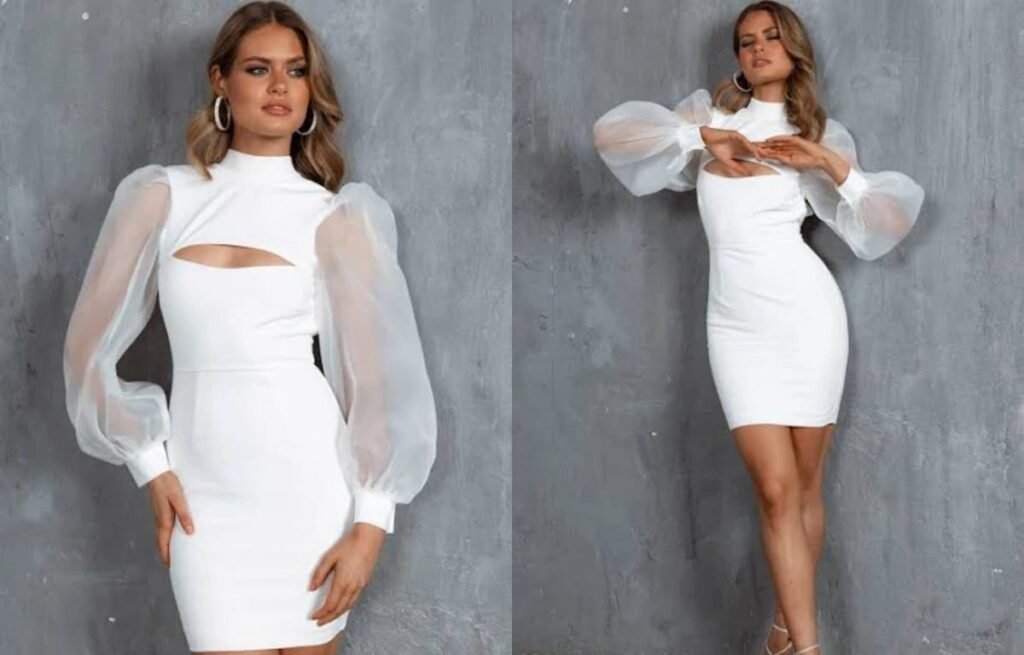
What makes the transparent puff sleeve with boning so unique in fashion design?
This sleeve type blends visual softness with hidden structure—perfect for modern statement pieces.
The transparent puff sleeve with boning combines sheer volume and inner rigidity. It uses materials like organza or tulle for puffiness, reinforced with vertical boning to hold a dramatic, floating silhouette without collapsing.
How is a transparent puff sleeve with boning constructed?
It looks delicate, but the engineering underneath is precise.
This sleeve starts with a translucent fabric like organza or mesh, cut into exaggerated puff shapes. Boning strips—usually plastic or spiral steel—are sewn vertically inside the puff to support height and volume.
The boning is carefully stitched between fabric layers or into casing channels, so it’s invisible from the outside but essential for form retention.
Key construction details:
- Outer fabric: Sheer, lightweight (e.g. organza, mesh, tulle)
- Support: Vertical boning strips (3–5 per sleeve depending on design)
- Finish: Clean binding at cuff and shoulder for comfort
What design benefits does this sleeve offer?
It brings both visual drama and stability to the upper silhouette.
Unlike a standard puff sleeve that can deflate over time, boning maintains the sculptural shape. This allows for bold silhouettes while keeping the garment light and breathable.
I worked with a client designing a bridal top with transparent puff sleeves. Without boning, the sleeve collapsed after an hour. Once we added hidden boning, the shape stayed perfect the entire day.
Engineering Fashion with Transparent Boned Sleeves
1. Material selection is everything
To achieve structure with airiness, designers must balance sheerness and stiffness:
- Best fabrics: Organza, tulle, silk organza, fine mesh
- Avoid: Chiffon or georgette—they’re too limp to hold boning
Boning must also match the fabric weight. Spiral steel works for structured pieces; plastic Rigilene is better for flexible designs.
2. Boning placement affects silhouette
The number and spacing of boning strips directly influence the sleeve shape:
| Boning Layout | Effect on Sleeve |
|---|---|
| 3 evenly spaced strips | Soft round puff |
| 4–5 strips + wide spacing | More volume, airy balloon |
| Closely spaced verticals | Column-like, futuristic structure |
3. Styling and garment context
This sleeve type pairs best with:
- Minimal bodices: to highlight the sleeve
- Corset tops or fitted dresses: balance between volume and shape
- Eveningwear or couture: where drama and form are welcome
But it’s also showing up in Gen Z streetwear, with cropped tops and exaggerated proportions gaining attention on Instagram and TikTok.
4. Practical Considerations
Storage: Should be hung carefully to avoid distorting sleeve shape
Weight: Boning adds light structure, not heaviness
Durability: Needs reinforced stitching at boning points
Scalloped Edge Sleeve
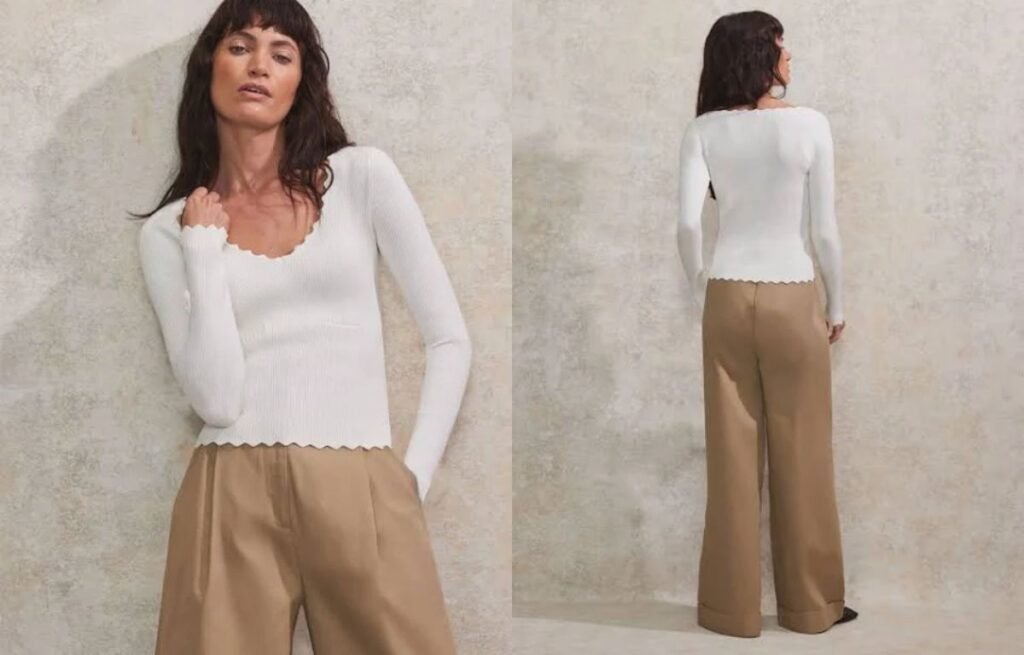
Why is the scalloped edge sleeve a timeless detail in women’s fashion?
Delicate, decorative, and eye-catching—scalloped edges make a quiet yet powerful statement.
Scalloped edge sleeves feature a soft, curved trim that resembles the edge of a seashell. They add a feminine and vintage-inspired touch, commonly used in blouses, dresses, and summerwear. This design blends simplicity with ornamental detail.
What makes scalloped edge sleeves different from other decorative sleeve finishes?
It’s more than just a pretty curve—it’s technique meets aesthetics.
Unlike frills or lace trims that are added as separate elements, scalloped edges are usually cut and finished directly on the fabric, becoming part of the sleeve’s structure. This creates a cleaner, more intentional design.
When done well, scalloped edges signal quality and craftsmanship, especially when paired with embroidery or delicate fabrics.
The Design Function and Impact of Scalloped Edge Sleeves
1. Design Construction & Techniques
- Cutting and Finishing:
Scalloped edges are usually cut using custom patterns or dies, then finished with careful stitching, embroidery, or laser-cut techniques. This precision sets it apart from mass-market trims. - Stability Challenges:
Without proper interfacing or edge reinforcement, scallops may warp or fray—making it important to match fabric type with the right finishing method.
2. Fabric Compatibility
| Fabric Type | Suitability for Scalloped Edge |
|---|---|
| Cotton Poplin | ✅ Excellent for structured scallops |
| Linen | ✅ Crisp edges with summery appeal |
| Lace | ✅ Often features built-in scallops |
| Jersey Knit | ⚠ May require stabilizing techniques |
| Chiffon/Organza | ⚠ Needs backing or embroidery for stability |
Soft woven fabrics are ideal, especially those with clean, crisp finishes. Heavier knits or overly stretchy materials may distort the curve.
3. Style Impacts
- Feminine Aesthetic:
Scalloped sleeves immediately soften a garment’s tone, making even minimalist designs feel more romantic. - Vintage & Retro Feel:
Common in 1950s-inspired silhouettes, this finish evokes nostalgia while staying elegant. - Summer & Resort Vibes:
Lightweight tops and sundresses with scalloped sleeves feel breezy, delicate, and thoughtfully designed.
4. Consumer & Market Relevance
Scalloped edge sleeves appeal strongly to certain buyer types:
- Young professional women looking for soft-feminine workwear
- Occasionwear brands wanting clean but decorative sleeve styles
- Resort & lifestyle labels that value artisanal construction details
I’ve noticed that when clients use scalloped edges in clean silhouettes (like a cap sleeve or short puff), they get better engagement—especially on platforms like Instagram and Pinterest.
Draped Cowl Sleeve
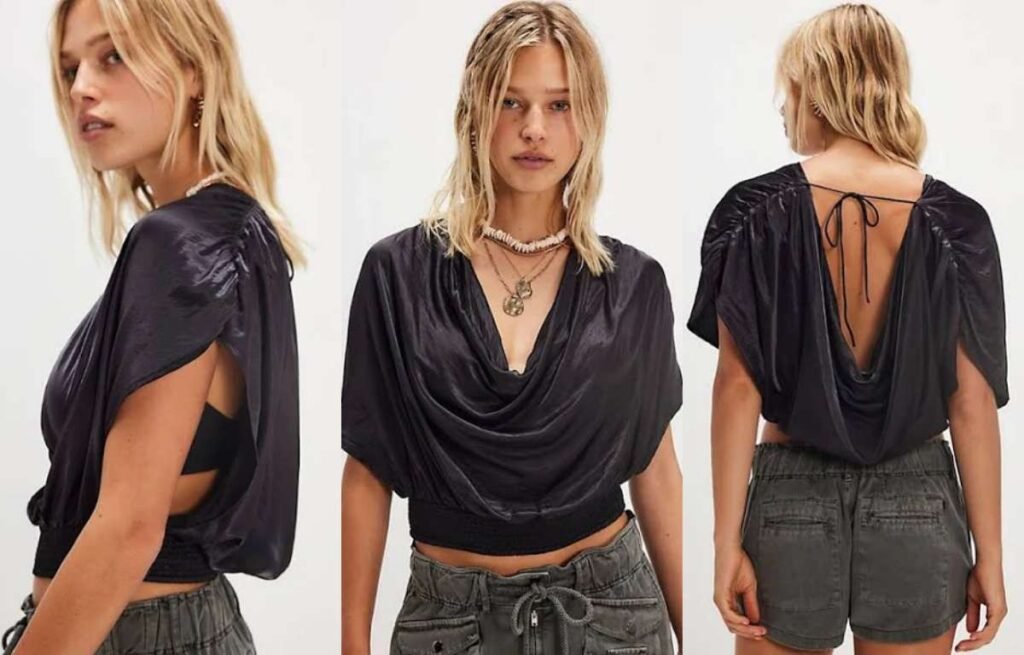
Draped Cowl Sleeve: The Elegant, Flowing Design
The Draped Cowl Sleeve is a sophisticated and fluid sleeve style that brings softness and elegance to any garment.
This sleeve features a loose, draped fabric that gathers naturally around the arm, creating a flowing, almost waterfall-like effect. It’s often seen in evening wear, blouses, and dresses, adding a relaxed yet refined feel to a look.
Why is the Draped Cowl Sleeve so Popular?
Draped cowl sleeves exude effortless elegance and add a touch of drama without being too overbearing.
The key appeal of the draped cowl sleeve lies in its ability to provide structure while maintaining a sense of softness and movement. It transforms simple garments into more sophisticated pieces by introducing texture and flow, which creates a dynamic visual effect.
Analyzing the Appeal of Draped Cowl Sleeves
- Softness and Flow: The draping effect of the cowl sleeve creates a sense of fluidity and movement, which enhances the garment’s overall visual appeal. The way the fabric gathers and falls adds depth and softness, making it perfect for creating feminine silhouettes.
- Flattering Fit: The draped effect can camouflage areas of the upper body, providing a flattering fit for many body types. It softens the shoulder area, giving the wearer a smooth and balanced shape.
- Versatility in Design: Draped cowl sleeves can be used in various styles, from casual to formal. They are ideal for layering, as the natural flow allows them to pair well with different fabrics, such as silk, jersey, or chiffon, creating a wide range of looks—from relaxed chic to refined evening wear.
- Creating Dimension: The draping creates a dimensional effect, breaking up the plain silhouette of a top or dress. This subtle yet striking detail elevates the garment and adds an element of interest without overwhelming the design.
- Timeless Elegance: The draped cowl sleeve is a classic design that never goes out of style. It’s especially effective in evening wear and formal outfits, as it adds a timeless, graceful element that feels both contemporary and vintage.
Draped Cowl Sleeve vs. Other Draped Sleeves
| Feature | Draped Cowl Sleeve | Kimono Sleeve | Batwing Sleeve |
|---|---|---|---|
| Shape | Soft drape around the arm | Wide, straight cut | Full, loose, and bat-shaped |
| Look | Feminine, elegant | Relaxed, cultural | Bold, relaxed |
| Best Use | Evening wear, blouses | Casual, bohemian | Casual, oversized styles |
| Fabric Choice | Silk, chiffon, jersey | Cotton, linen | Jersey, knit |
Best Fabrics for Draped Cowl Sleeves
The right fabric is essential for achieving the soft, flowing effect that defines the draped cowl sleeve. Here are the best fabric choices:
- Chiffon: Lightweight and sheer, perfect for a flowing, airy effect.
- Silk: Adds elegance and a luxurious drape.
- Jersey: Offers stretch, allowing the fabric to naturally fall and conform to the body.
- Satin: Provides a smooth, high-shine finish that enhances the draping.
Styling Tips for Draped Cowl Sleeves
Pair draped cowl sleeves with streamlined, fitted bottoms to create balance and highlight the softness of the sleeves. For evening wear, opt for solid colors or soft metallics to let the fabric shine. When accessorizing, choose simple, delicate jewelry to complement the graceful drape without competing with it.
Convertible Zip-Off Sleeve

Convertible Zip-Off Sleeve: Versatility Meets Practicality
The Convertible Zip-Off Sleeve is a highly functional and stylish sleeve design, often used in outdoor and activewear.
This sleeve design features zippers that allow the sleeve to be easily removed, transforming a long-sleeve garment into a short-sleeve one. It’s perfect for those seeking adaptable clothing for changing weather conditions or a versatile look.
I first encountered this sleeve in a convertible jacket, and it immediately struck me as an ingenious way to offer two styles in one garment.
Why is the Convertible Zip-Off Sleeve So Popular?
The Convertible Zip-Off Sleeve combines practicality with style, offering users flexibility without compromising fashion.
It allows wearers to adjust their look and comfort level with ease, making it an ideal choice for transitional weather, travel outfits, or outdoor activities where adaptability is key.
Functionality and Design Analysis
The convertible zip-off sleeve might seem simple, but there are a few key design elements that make it so popular:
- Practicality and Adaptability:
One of the most significant advantages of zip-off sleeves is their ability to quickly adapt to changing environments. Whether you’re hiking, traveling, or simply moving between indoor and outdoor spaces, the zipper feature lets you adjust your outfit instantly. This functionality makes it a staple in activewear and versatile travel wardrobes. - Comfort in Varying Conditions:
The design provides comfort in varying temperatures. In cooler conditions, the long sleeves provide warmth and coverage. When the temperature rises or you need more ventilation, the sleeves can be removed in seconds, ensuring you stay comfortable throughout the day. - Modern Design Aesthetic:
While the zip-off feature is functional, it also adds a modern, sleek aesthetic to the garment. The zippers themselves can be designed as part of the overall look, adding an edge to the clothing. The streamlined look of zip-off sleeves works particularly well with minimalist or sportswear-inspired fashion. - Layering Potential:
The zip-off sleeve feature also offers a unique opportunity for layering. When the sleeves are removed, the garment can be worn as a sleeveless or short-sleeve piece, allowing for versatile layering options depending on the outfit or weather. - Sustainability and Long-Term Use:
The convertible nature of the sleeve makes the garment more sustainable, as it can be adapted for different seasons or occasions. Instead of needing separate garments for different conditions, the zip-off sleeve offers a one-piece solution for various needs.
Key Design Considerations:
- Zipper Placement: Zippers should be strategically placed to ensure they don’t interfere with comfort or mobility when the sleeves are attached.
- Fabric Choice: Durable, stretchable fabrics like nylon, spandex, or soft-shell material work best to ensure the garment remains functional and comfortable when the sleeves are removed.
- Fit and Cut: The garment should fit snugly when the sleeves are on and allow ease of movement without being too loose when the sleeves are removed.
Convertible Zip-Off Sleeve vs. Other Sleeve Designs
| Feature | Convertible Zip-Off Sleeve | Roll-Up Sleeve | Classic Long Sleeve |
|---|---|---|---|
| Functionality | Adjustable, versatile | Fixed, casual look | Standard, no adjustability |
| Weather Adaptability | Great for varying conditions | Good for moderate warmth | Limited to one season |
| Aesthetic | Sporty, modern | Relaxed, casual | Classic, formal |
| Ideal Occasions | Outdoor, travel, sports | Casual outings | Formal, everyday |
Best Fabrics for Convertible Zip-Off Sleeves
For this design to work effectively, the fabric choice is crucial. Here are the best materials:
- Nylon/Polyester Blends: Lightweight, durable, and moisture-wicking—perfect for active wear.
- Soft-Shell Fabric: Ideal for outdoor jackets and weatherproof gear.
- Stretchy Fabrics: Materials like spandex or elastane provide comfort and allow ease of movement when the sleeves are zipped off.
Related Articles
The Ultimate Guide to 80+ Types of Sleeves for Women’s Fashion and Design(Part 1)
The Ultimate Guide to 80+ Types of Sleeves for Women’s Fashion and Design(Part 2)
The Ultimate Guide to 80+ Types of Sleeves for Women’s Fashion and Design(Part 3)



